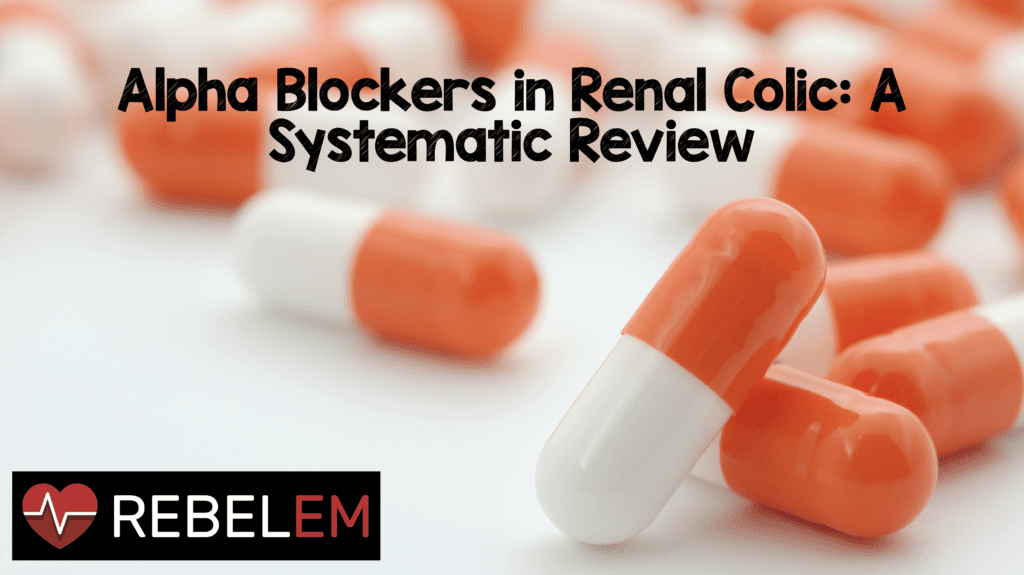
Over the past 3-4 years, a small number of higher-quality RCTs have been published (Ferre 2009, Pickard 2015, Furyk 2016). These studies have demonstrated a lack of benefit for routine use of alpha blockers. However, secondary outcomes suggest a possible benefit in larger stones (> 6 mm). In spite of recent multiple studies, the use of alpha blockers remains an area of active debate.
Article:Hollingsworth JM et al. Alpha blockers for treatment of ureteric stones: systematic review and meta-analysis. BMJ 2016. PMID: 27908918
Clinical Question: Are alpha blockers effective in facilitating the passage of ureteric stones and are there specific groups that appear to stand more benefit?
Population: All randomized controlled trials looking at alpha blockers compared to either placebo or control in the treatment of ureteric stones.
Outcomes: Facilitation of ureteric stone passage, stone passage in stones < 6 mm, stone passage for stones > 6 mm, time to stone passage, episodes of pain, need for surgical intervention, admission to hospital
Design: Systematic review and meta-analysis following the PRISMA guidelines. Searched multiple data sources (Cochrane Central Register of Controlled Trials, Web of Science, Embase, LILACS, Medline etc).
Primary Results:
- Database search resulted in 443 possible articles
- 55 studies ultimately included in systematic review and meta-analysis
Critical Findings:
- (RR = Risk Ratio)
- Alpha blockers facilitate stone passage: RR = 1.49 (CI: 1.39 – 1.61)
- Smaller stones (generally < 5 mm)
- No benefit in stone passage
- RR = 1.19 (CI 1.00 – 1.48)
- Larger stones (generally > 6 mm)
- Modest benefit
- RR = 1.57 (1.17 – 2.27)
- Smaller stones (generally < 5 mm)
- Shorter time to passage with alpha blockers: – 3.79 days (CI -4.45 to -3.14)
- Lower risk of surgical intervention: RR = 0.44 (CI 0.37 – 0.52)
- Lower risk of admission to hospital: RR 0.37 (CI 0.22 – 0.64)
Strengths:
- Used PRISMA guidelines
- Considered all randomized controlled trials in any language
- Used multiple databases to ensure thorough identification of relevant studies
Limitations:
- Only a few of the studies included were at low risk for bias in regards to sequence generation, allocation concealment, blinding of participants, personnel and outcome assessors and incomplete outcome data (Figure 2 of study)
- Only 14 out of 55 included studies that had a placebo arm
- The authors included studies that did not blind patients or providers to treatment arm and studies that did not blind the assessors to allocation
- Overall, there was significant methodology and study heterogeneity raising the question of whether meta-analysis was appropriate.
Authors Conclusions:
“Alpha blockers seem efficacious in the treatment of patients with ureteric stones who are amenable to conservative management. The greatest benefit might be among those with larger stones. These results support current guideline recommendations advocating a role for alpha blockers in patients with ureteric stones.”
Our Conclusions: This systematic review and meta-analysis included studies at considerable risk for bias based on the methodology employed in the study. Of particular concern is the lack of blinding of the patient, investigator and outcome assessor in most of the studies. Based on the included studies, it appears that there is no benefit in terms of passage rate for smaller stones (< 5 mm) but there may be a small benefit for larger stones (> 5 mm). Further high-quality, RDCTs should be undertaken looking specifically at the passage of larger stones.
Potential to Impact Current Practice:
The available high-quality evidence does not show a benefit to alpha blockers in renal colic. There appears to be evidence supporting use only in larger stones. However, this comes with the caveat that to apply this information, we would have to obtain advanced imaging of all patients with ureteric colic which, we know, is not necessary. If you decide to scan a patient and you find a stone < 5 mm, it is unlikely that an alpha blocker is useful. On the other hand, if you find a stone > 5 mm, consideration of adding an alpha blocker to treatment is reasonable. As the majority of renal calculi we encounter are < 5 mm, the small benefit of alpha blockers in larger stones should not shift the providers towards expanded use of advanced imaging.
Clinical Bottom Line:
This systematic review and meta-analysis is an excellent example of the “crap in = crap out” theory. Recent high quality RCTs have demonstrated that in a general population of patients presenting with renal colic, alpha blockers add no additional benefit to symptomatic management. The very same studies suggest that there may be a small benefit in the subset of patients presenting with large stones. The addition of multiple low quality studies at significant risk for bias, add nothing but statistical noise to these high quality randomized control trials. Given the totality of the data, the universal use of alpha blockers to all patients with renal colic is not supported by the available evidence.
References:
- Al-Ansari et al. Efficacy of Tamsulosin in the Management of Lower Ureteral Stones: A Randomized Double-blind Placebo-controlled Study of 100 Patients. Urology 2010; 75: 4-8. PMID: 20109697
- Ferre RM et al. Tamsulosin for Ureteral Stones in the ED: a Randomized, Controlled Trial. Ann of EM 2009; 54: 432-9. PMID: 19200622
- Furyk JS et al. Distal ureteric stones and tamsulosin: a double-blind, placebo-controlled, randomized, multicenter trial. Ann Emerg Med 2016; 67(1): 86-95. PMID: 26194935
- Hermanns T et al. Is There a Role for Tamsulosin in the Treatment of Distal Ureteral Stones of 7 mm or less? Results of Randomised, Double-Blind, Placebo-Controlled Trial. European Urology 2009; 56(3): 407-12. PMID: 19375849
- Picard R et al. Medical expulsive therapy in adults with ureteric colic: a multicentre, randomised, placebo-controlled trial. Lancet 2015; 386(9991): 341-9. PMID: 25998582
- Segura JW et al. The American Urological Association. Ureteral Stones Clinical Guidelines Panel summary report on the management of ureteral calculi. J Urol. 1997;158(5):1915-1921. PMID: 9334635
- Singh A et al. A Systemic Review of Medical Therapy to Facilitate Passage of Ureteral Calculi. Ann of EM 2007; 50: 552-63. PMID: 17681643
- Vincendeau S et al. Tamsulosin hydrochloride vs Placebo for Management of Distal Ureteral Stones. Arch Intern Med 2010; 170(22): 2021-7. PMID: 21149761
Checkout More At:
- EM Lit of Note: Finally, an End to Tamsulosin for Renal Colic?
- REBEL EM: Does Use of Tamsulosin in Renal Colic Facilitate Stone Passage?
Post Peer Reviewed By: Thanks to Rory Spiegel for providing peer review for this post.
This post is cross-posted over at Core EM.



